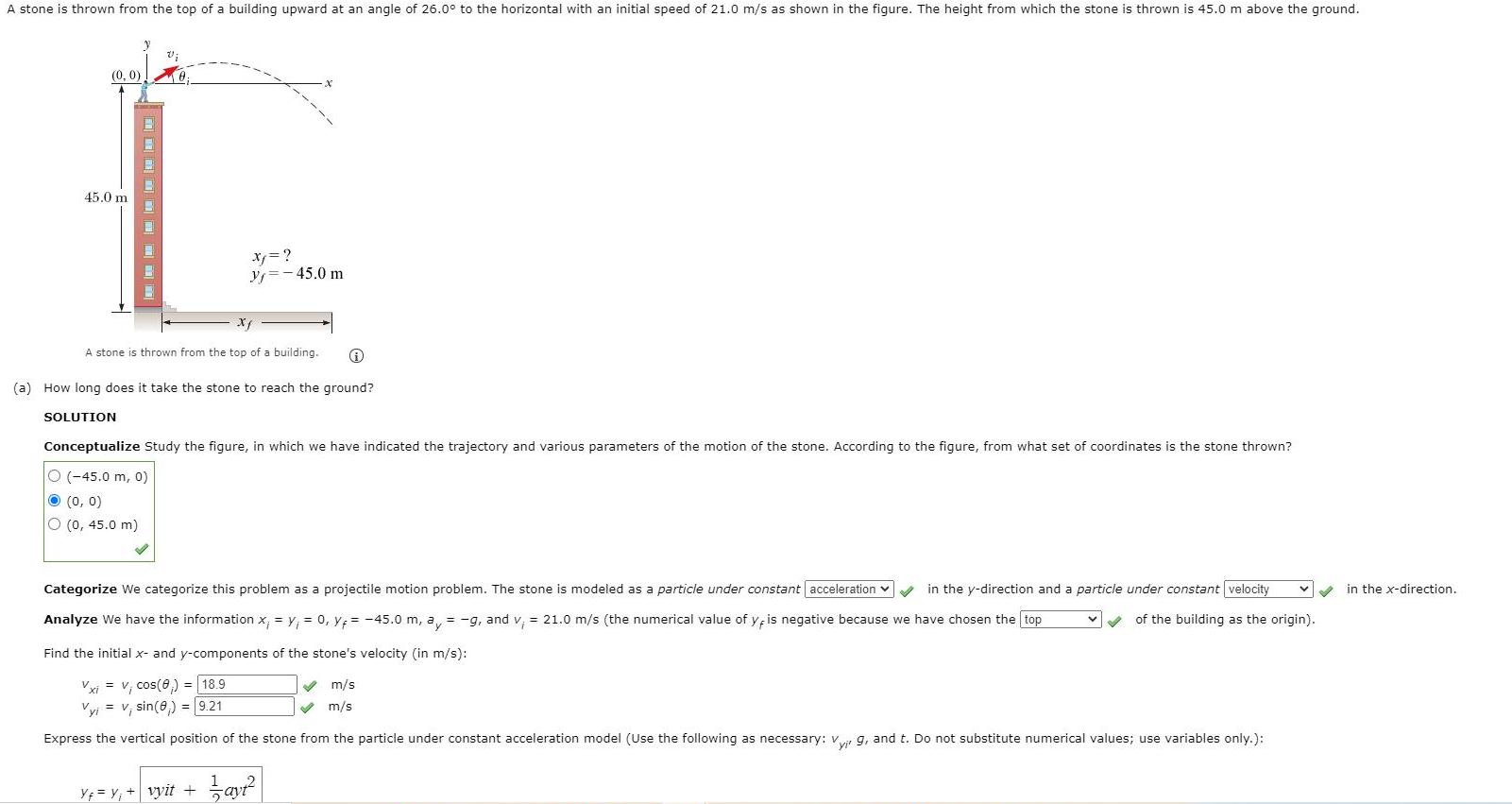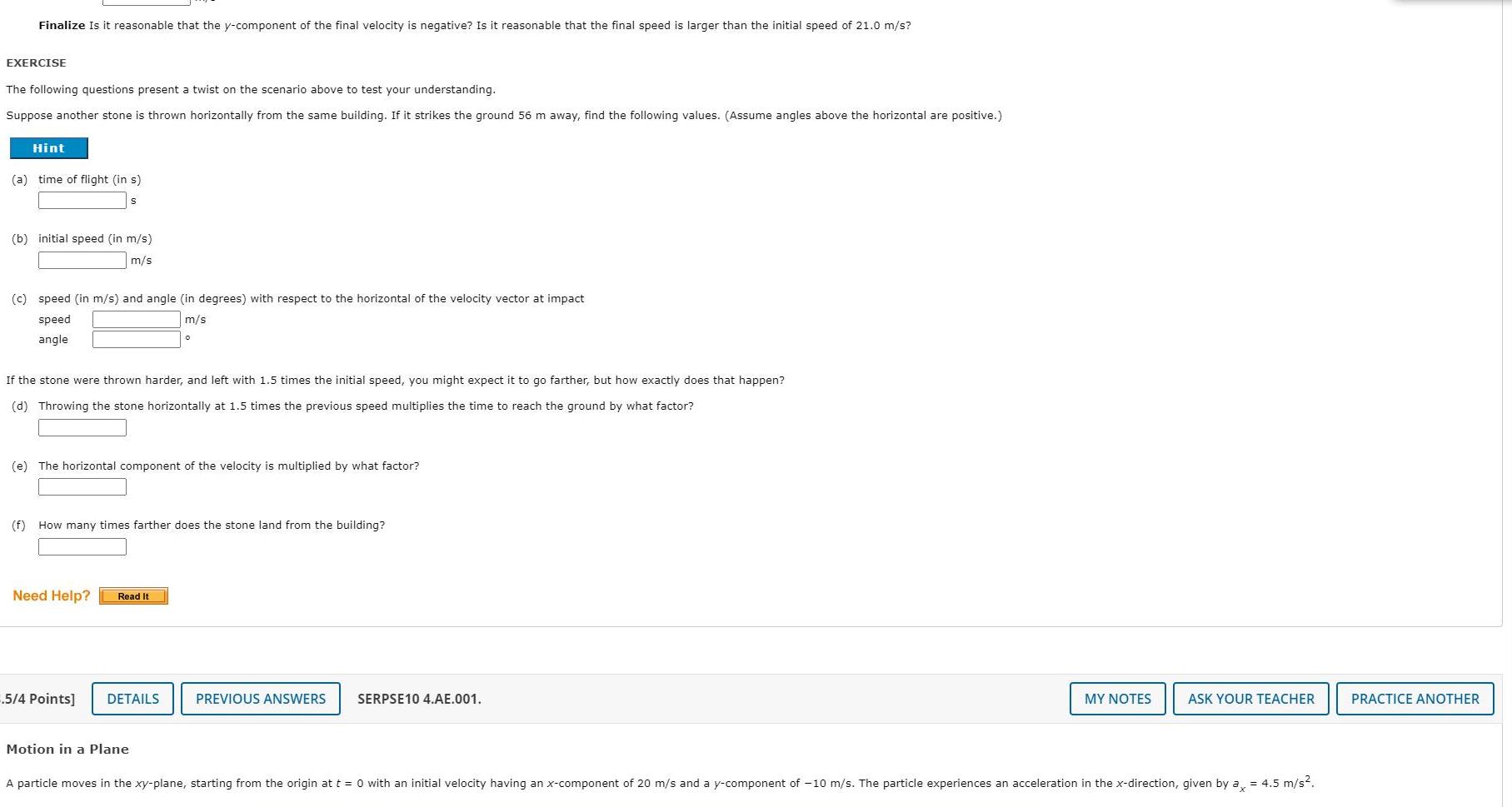Answered step by step
Verified Expert Solution
Question
1 Approved Answer
A stone is thrown from the top of a building upward at an angle of 26.0 to the horizontal with an initial speed of



A stone is thrown from the top of a building upward at an angle of 26.0 to the horizontal with an initial speed of 21.0 m/s as shown in the figure. The height from which the stone is thrown is 45.0 m above the ground. (0, 0) 45.0 m *= ? y=-45.0 m A stone is thrown from the top of a building. (a) How long does it take the stone to reach the ground? SOLUTION Conceptualize Study the figure, in which we have indicated the trajectory and various parameters of the motion of the stone. According to the figure, from what set of coordinates is the stone thrown? O (-45.0 m, 0) O (0, 0) O (0, 45.0 m) Categorize We categorize this problem as a projectile motion problem. The stone is modeled as a particle under constant acceleration in the y-direction and a particle under constant velocity in the x-direction. Analyze We have the information x, = y, = 0, y; = -45.0 m, a, = -g, and v, = 21.0 m/s (the numerical value of y, is negative because we have chosen the top of the building as the origin). Find the initial x- and y-components of the stone's velocity (in m/s): Vxi = v, cos(e) = 18.9 Vyi = v, sin(8,) = 9.21 V m/s m/s Express the vertical position of the stone from the particle under constant acceleration model (Use the following as necessary: Va g, and t. Do not substitute numerical values; use variables only.): Yf = Y; + vyit + Find the initial x- and y-components of the stone's velocity (in m/s): Vxi = v, cos(8) = 18.9 Vyi = v, sin(8,) = 9.21 V m/s V m/s Express the vertical position of the stone from the particle under constant acceleration model (Use the following as necessary: v 9, and t. Do not substitute numerical values; use variables only.): Y; = Y, + vyit + ayr? Substitute numerical values: m/s)t + (-9.80 m/s)2 -45.0 m = 0 + 9.21 Solve the quadratic equation to calculate t (in s): t = 3.03 s (b) What is the speed of the stone just before it strikes the ground? SOLUTION Use the velocity equation in the particle under constant acceleration model to obtain the y-component of the velocity of the stone just before it strikes the ground (Use the following as necessary: v 9, and t. Do not substitute numerical values; use variables only.): 1 "y = Vy -ayr? Substitute numerical values (Enter your answer in m/s.): Vyf = m/s Use this component with the horizontal component v = v = 18.9 m/s to find the speed of the stone (in m/s) at t: VE = V V + Vyf m/s Finalize Is it reasonable that the y-component of the final velocity is negative? Is it reasonable that the final speed is larger than the initial speed of 21.0 m/s? EXERCISE The following questions present a twist on the scenario above to test your understanding. Suppose another stone is thrown horizontally from the same building. If it strikes the ground 56 m away, find the following values. (Assume angles above the horizontal are positive.) Hint (a) time of flight (in s) Finalize Is it reasonable that the y-component of the final velocity is negative? Is it reasonable that the final speed is larger than the initial speed of 21.0 m/s? EXERCISE The following questions present a twist on the scenario above to test your understanding. Suppose another stone is thrown horizontally from the same building. If it strikes the ground 56 m away, find the following values. (Assume angles above the horizontal are positive.) Hint (a) time of flight (in s) (b) initial speed (in m/s) m/s (c) speed (in m/s) and angle (in degrees) with respect to the horizontal of the velocity vector at impact speed m/s angle If the stone were thrown harder, and left with 1.5 times the initial speed, you might expect it to go farther, but how exactly does that happen? (d) Throwing the stone horizontally at 1.5 times the previous speed multiplies the time to reach the ground by what factor? (e) The horizontal component of the velocity is multiplied by what factor? (f) How many times farther does the stone land from the building? Need Help? Read It .5/4 Points] DETAILS PREVIOUS ANSWERS SERPSE10 4.AE.001. MY NOTES ASK YOUR TEACHER PRACTICE ANOTHER Motion in a Plane A particle moves in the xy-plane, starting from the origin at t = 0 with an initial velocity having an x-component of 20 m/s and a y-component of -10 m/s. The particle experiences an acceleration in the x-direction, given by a, = 4.5 m/s2.
Step by Step Solution
★★★★★
3.40 Rating (153 Votes )
There are 3 Steps involved in it
Step: 1

Get Instant Access to Expert-Tailored Solutions
See step-by-step solutions with expert insights and AI powered tools for academic success
Step: 2

Step: 3

Ace Your Homework with AI
Get the answers you need in no time with our AI-driven, step-by-step assistance
Get Started


